Deidamia inscriptum
Deidamia inscriptum
dee-ih-DAY-mee-uhMin-SKRIP-tum
(Harris, 1839)
Pterogon? inscriptum
Lettered Sphinx
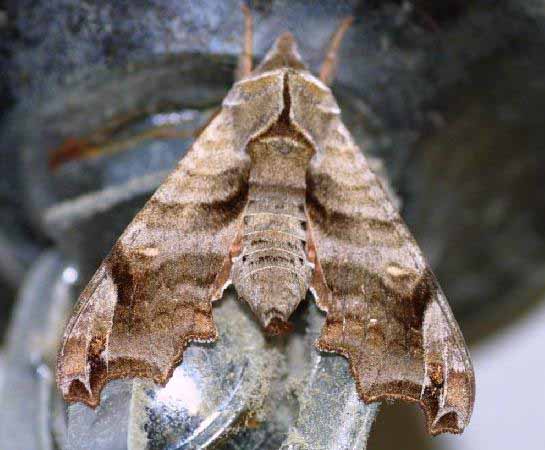
Deidamia inscriptum courtesy of James Reilly.
This site has been created by Bill Oehlke.
Comments, suggestions and/or additional information are welcomed by Bill.
| TAXONOMY:
Superfamily: Sphingoidea, Dyar, 1902
Family: Sphingidae, Latreille, 1802
Subfamily: Macroglossinae, Harris, 1839
Tribe: Macroglossini, Harris
Genus: Deidamia, Clemens, 1859
Species: inscriptum, (Harris, 1839) |
DISTRIBUTION:
The Lettered Sphinx Moth, Deidamia inscriptum
(Wing span: 1 3/4 - 2 3/4 inches (4.5 - 7 cm)), flies from
New Hampshire south to northern Florida and southern Alabama
(Houston County (JS)); west to Minnesota,
Nebraska, Oklahoma, and Texas. The specimen type locality is
Indiana. It also flies in southern Ontario and is occasionally seen
in southern Quebec.
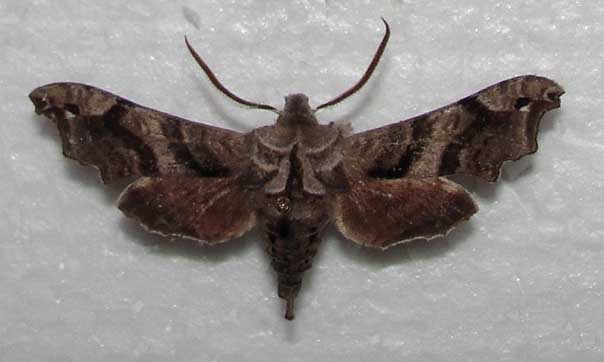
Deidamia inscriptum, Willshire, Van Wert County, Ohio,
May 12, 2012, courtesy of Greg Roehm.
Visit Deidamia inscriptum, Fillmore, Bossier Parish, Louisiana, March 8, 2013; Caddo Parish, March 16, 2013; Jeff Trahan
Visit Deidamia inscriptum male, Vogel State Park,
Union County, Georgia, April 9, 2009, courtesy of Aubrey Scott.
Visit Deidamia inscriptum in copula, May 21, 2011, Ian Miller.
Visit Deidama inscriptum male, 1:45 am, Eau Claire County, Wisconsin, May 19, 2011, Ian Miller.
The moth's outer margin of the forewing is deeply scalloped.
The upperside is light brown with dark brown markings.
There is a small black and white spot near the tip. The upperside
of the hindwing is orange-brown with a dark brown outer margin and
median line. Males rest with the typical strong curve to the abdomen, depicted in
John Himmelman image (Connecticut, May 1, 2002) right. This is usually one of the earliest
Sphingids to fly each season. | 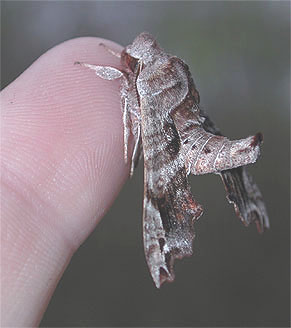 |
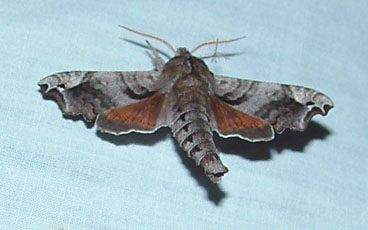 |
Tim Dyson captured this fresh male with wings exposed in Peterborough, Ontario,
on May 25, 2005.
Tim writes, "I had the bedsheet/light set up going the other night,
and this little guy came along.
First sphinx of the season for me."
With an adjustment to the shutter speed on his camera, Tim captured this one in
flight. Nice to see the hindwings on a live specimen!
|
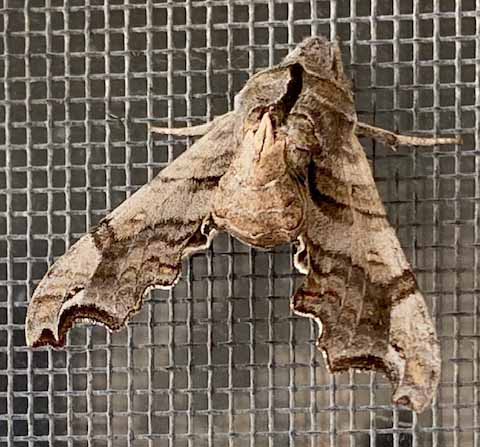
Deidamia inscriptum Ettrick, Trempealeau County, Wisconsin,
April 26, 2020, courtesy of Donald Severson,
Donald Severson writes, "This is a neat moth that's been sitting on our screen today. Its tail sticks up like a scorpion. We live near Ettrick in
Trempealeau County, Wisconsin."
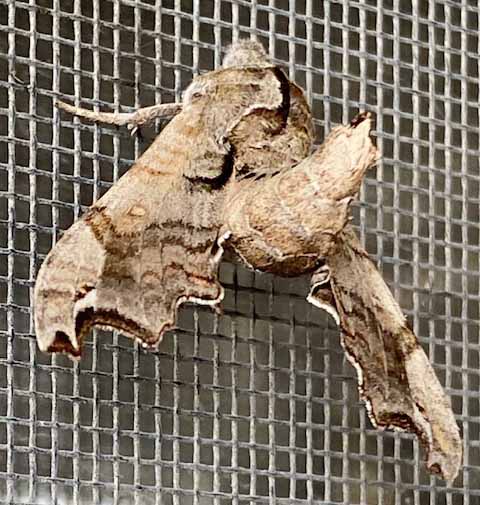
Deidamia inscriptum Ettrick, Trempealeau County, Wisconsin,
April 26, 2020, courtesy of Donald Severson.
FLIGHT TIMES AND PREFERRED FOOD PLANTS:
Deidamia
inscriptum adults are on the wing as a single generation from
February-May in Louisiana, and from March-June in the remainder of
the range. Lynda McGinnis reports a specimen coming to a
blacklight on April 22, 2003 in Missouri, on a very cold night,
temperature below 45 F.
Adults feed from flowers including lilac
(Syringa vulgaris) and Phlox.
Deidamia inscriptum undersides, Peterborough,
Ontario, courtesy of Tim Dyson. |
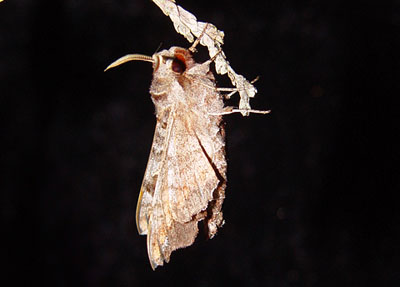 |
Randy Lyttle reports a specimen at lights on April 16-17, 2009, in Clay, Onondaga County, New York.
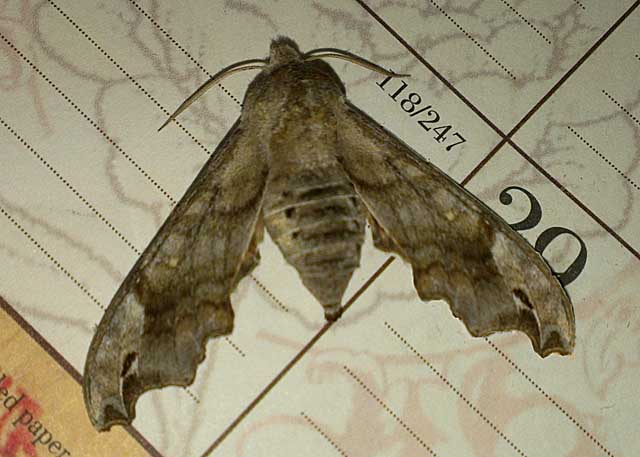
Deidamia inscriptum female, Grady County, Oklahoma,
April 15, 2013, courtesy of Jessica Townsend, slight digital repair by Bill Oehlke.
Note the very plump, egg-laden, abdomen of the female above.
ECLOSION, SCENTING AND MATING:
Pupae wiggle to surface
just prior to eclosion. Females call at night,
and males fly into the wind to pick up and track the pheromone plume. The species is also active during the day.
EGGS, LARVAE AND PUPAE:Females
lay translucent green eggs singly on leaves of the host plant.
Grape (Vitis), ampelopsis (Ampelopsis), and
Virginia creeper (Parthenocissus) all serve as larval hosts.
Mark Black sends the image to the right, June 18, 2006, of a larva
on grape. Id confirmed by Jim Tuttle. |
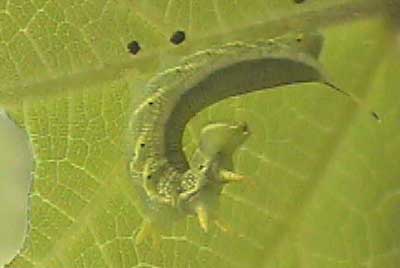 |
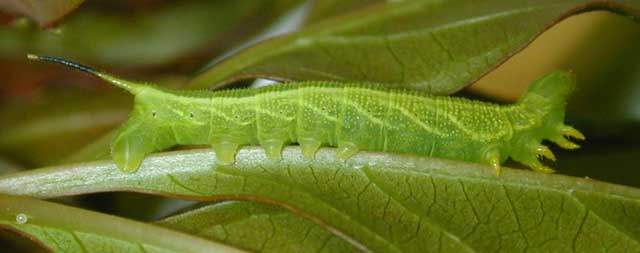
Deidamia inscriptum third instar, March 30, 2008,
Bexar County, Texas, March 30, 2008,
courtesy of Michael van Buskirk
Of the larva depicted above, Michael van Buskirk writes,
"The D. inscriptum female was taken at light at
on local gas station-convenience mart at about 9:30pm in northwest
Bexar County, Texas, March 14, 2008. Ova were deposited March 14-16
and hatched March 22-24, 2008. The third instar photo was
taken on March 30, 2008.
"I have about (65) D. inscriptum larvae feeding on my local
Parthenocissus, and some of the larvae are going into 3rd
instar at only 8 days old! When they fill out, I will photograph and
send you some images, so that you will have 3rd & 4th larval instars
for your website. While common, I am setting my sights for all of the
local species I know are here, but have not found yet, except as
adults--D. hyloeus, S. jamaicensis, A. juglandis, P. plebeja, D.
choerilus, H. thysbe, C. undulosa, and E. vitis. Will also
be going after some rare ones, too, but the locals are more easy to
predict.
"As I said earlier, I think there may be some surprise species here as
well, such as S. istar, E. lassauxii, and others."
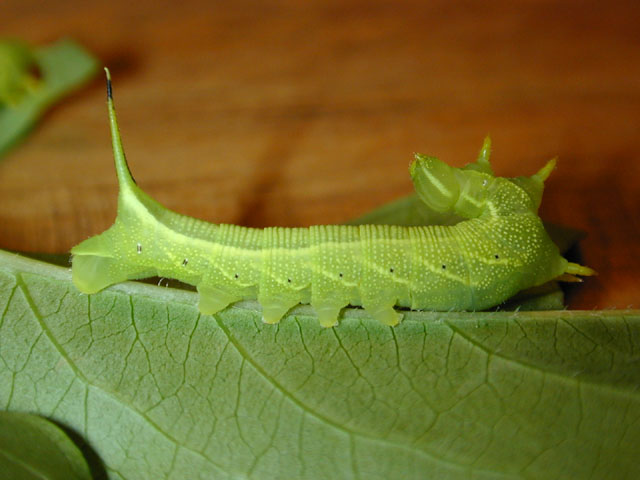
Deidamia inscriptum fourth instar, Bexar County, Texas,
April 3, 2008, twelve days out of egg, courtesy of
Michael van Buskirk
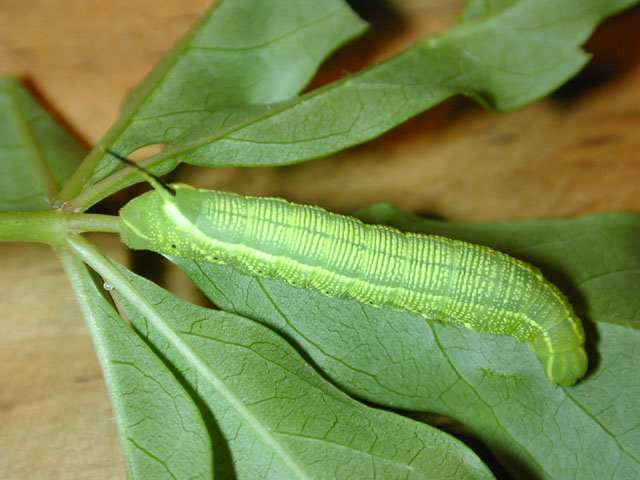
Deidamia inscriptum fourth instar, Bexar County, Texas,
April 3, 2008, twelve days out of egg, courtesy of
Michael van Buskirk
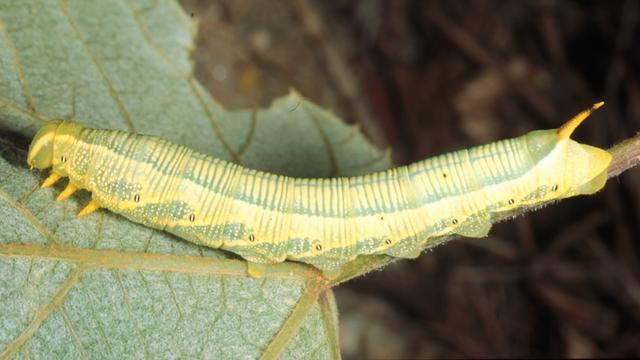
Deidamia inscripta courtesy/copyright
David Wagner.
Michael writes, "About (40) of the D. inscriptum larvae are
pre-pupal as of tonight (April 10). There are about (60) total. They
grew very quickly in 5th instar from the weekend, and seem about the
right size. I have a copy of Caterpillars and Their Moths,
by Ida M. Eliot and Caroline Gray Soule. Published in 1902, more
than a century ago, it still has some of the best rearing data
available for Sphingids."
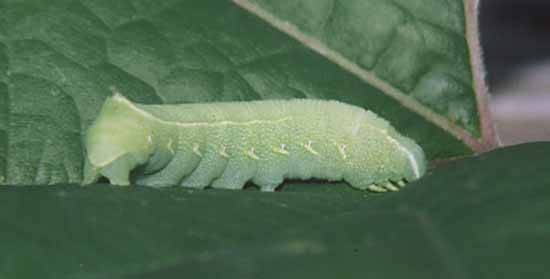
Deidamia inscriptum larva
courtesy of Mary Hallett, Beloit, Wisconsin.
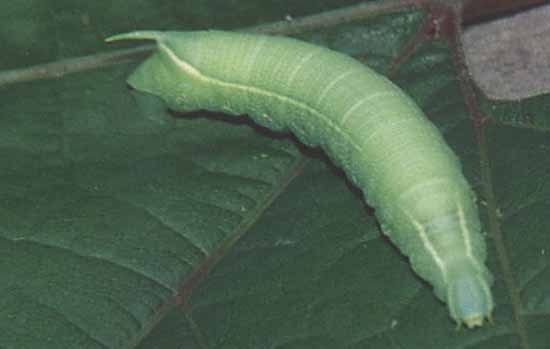
Deidamia inscriptum larva
courtesy of Mary Hallett, Beloit, Wisconsin.
I too have a copy of Caterpillars and Their Moths
which Bonnie Caruthers obtained for me. The extremely rapid
development of Sphingidae larvae, as documented in the book, surprised
me. I think many of the Sphingidae caterpillars feed at night. Under
natural conditions, cooler outdoor temperatures may reduce the
caterpillars' metabolic rates. Indoors, where there is often a warmer
nighttime temperature, the immatures tend to develop much more rapidly.
Michael's records indicate that larvae hatching on March 22 are near
pupation on April 10.
Larval Food Plants
Listed below are primary food plant(s) and alternate food plants. It is hoped that this
alphabetical listing followed by the common name of the foodplant will
prove useful. The list is not exhaustive. Experimenting with closely
related foodplants is worthwhile.
| Sourwood
Grape
Virginia Creeper
|
The pronunciation of scientific names is
troublesome for many. The "suggestion" at the top of the page is
merely a suggestion. It is based on commonly
accepted English pronunciation of Greek names and/or some
fairly well accepted "rules" for latinized scientific names.
The suggested pronunciations, on this page and on other pages,
are primarily put forward to assist those who hear with internal
ears as they read.
There are many collectors from different countries whose
intonations and accents would be different.
Some of the early describers/namers chose genus
and species names indicating some character of the insect, but more
often, they simply chose names from Greek or Roman mythology or
history.Those species names which end in "ensis" indicate a
specimen locale, and those which end in "i", pronounced "eye", honour
a contempory friend/collector/etc.
In Greek literature, Deidamia was one of
Lycomedes' daughters, and she bore a son, Neoptolemus, for Achilles.
The species name "inscriptum" MAY ? have been chosen for the parallel
"lines" on the forewings, suggesting lines of script.
Use your browser "Back" button to return to the previous page.
Goto Main Sphingidae Index
Goto Macroglossini Tribe
Goto Central American Indices
Goto Carribean Islands
Goto South American Indices
Goto U.S.A. tables
 | 
Show appreciation for this site by clicking on flashing butterfly to the left.
The link will take you to a page with links to many insect sites. |
















